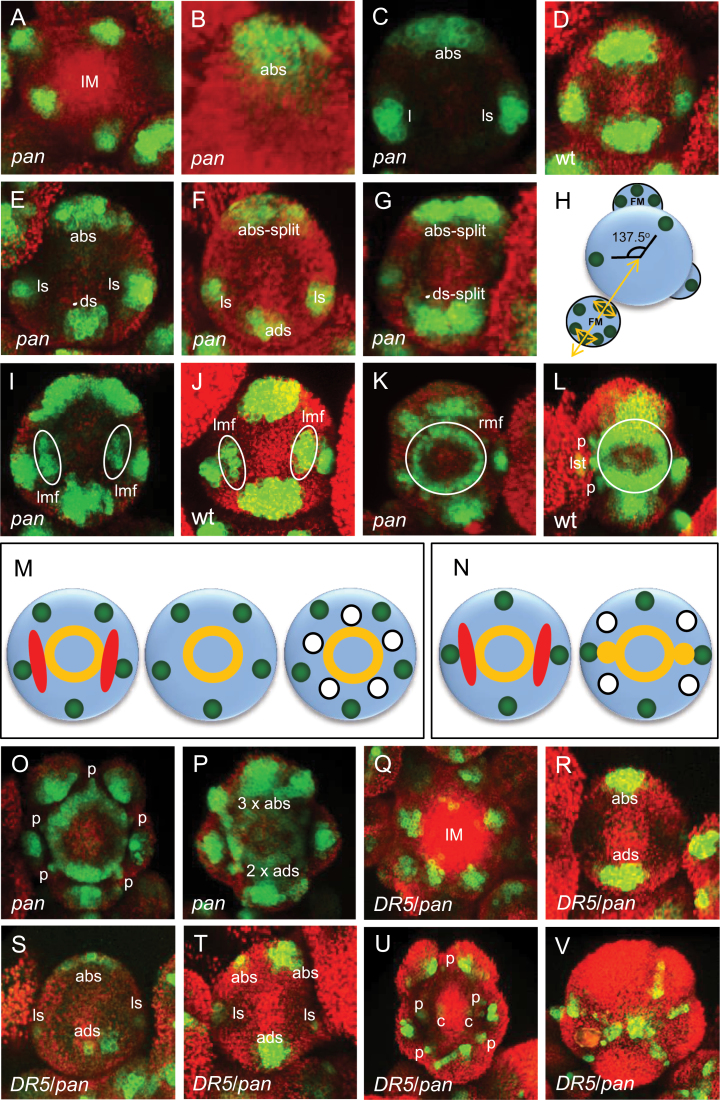Fig. 4.
Expression of DRNL::GFP and DR5 in pan-1 and wild type throughout floral development: (A) DRNL::GFP expression in the pan IM periphery; in an early stage-2 pan flower marking (B) the abaxial sepal; (C) the abaxial and two lateral sepals; (D) DRNL::GFP expression marking all four sepals in a wild-type stage-2 flower; (E) marking all sepals in a stage-2 pan flower (note the broadening of the abaxial domain); (F) in a late stage-2 pan flower showing the splitting of the abaxial sepal founder cell population into two discrete foci; (G) in a late stage-2 pan flower showing the splitting of the abaxial and adaxial sepal founder cell populations; (H) schematic diagram showing wild-type sequence of sepal initiation (green circles) as the FM separates from the IM, and the splitting of sepal founder cells in lateral directions from the abaxial and adaxial domains, along an abaxial/adaxial axis from the centre of the IM (yellow arrows); DRNL::GFP expression showing the two lateral expression domains inner to the sepal domain in (I) a stage-3 pan; (J) a stage-3 wild-type flower; (K) an early stage-4 pan flower showing the central ring-shaped domain (note the absence of petal or stamen founder cells); (L) a stage-4 wild-type flower, showing the central ring-shaped domain and the resolution of the lateral domains each into founder cells of two petals and one lateral stamen. (M) A schematic representation of DRNL expression in floral organ founder cells in the outer three whorls in stage-3 and 4 pan flowers, showing sepals in green, the lateral domains that subsequently disappear (red), the central ring-shaped domain (yellow) that will produce five radial stamens, and the initiation of five petals in a radial pattern interstitially between the sepals. (N) wild-type flowers, showing the sepals (green), the red lateral domains that each resolves into two petals, and a single lateral stamen domain and the central yellow ring-shaped domain that will give rise to the medial stamens. The location of the IM is to the bottom of each image. DRNL::GFP in (O) a late stage-4 pan flower (note the initiation of petal founder cells interstitially between the sepals); (P) a stage-4 pan flower showing splitting of the abaxial sepal founder cells into three and the adaxial into two petal founder cells, and the fragmentation of the ring-shaped domain into stamen founder cells. DR5::GFP expression in pan in (Q) the IM periphery; (R) the abaxial and adaxial sepals of a stage-2 flower; (S) all sepals in a stage-2 flower (note the broadening of the abaxial domain); (T) a late stage-2 flower after bifurcation of the abaxial sepal domain; (U) a stage-5 flower showing petal founder cells interstitially between the sepal primordia; (V) a stage-6 flower showing strong expression associated with the margins of the expanding sepals. Abbreviations: IM=inflorescence meristem; ab=abaxial sepal; ad=adaxial sepal; ls=lateral sepal; lmf=lateral morphogenetic field; p=petal; rmf=ring-shaped morphogenetic field; c=carpel. Red represents chlorophyll autofluorescence. (This figure is available in colour at JXB online.)

